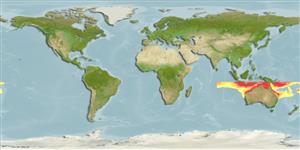Elasmobranchii (haaien en roggen) (sharks and rays) >
Carcharhiniformes (Ground sharks) >
Carcharhinidae (Requiem sharks)
Etymology: Rhizoprionodon: rhiza (Gr.), root; prion (Gr.) saw; odon (Gr.), tooth, referring to teeth with serrated (saw-like) bases, or roots [replacement name for Rhizoprion Ogilby 1915, preoccupied by Rhizoprion Jourdan 1861 in mammals]. (See ETYFish); taylori: In honor of entomologist Frank Henry Taylor (1886-1945), Institute of Tropical Medicine, Townsville, North Queensland, Australia, who collected holotype. (See ETYFish).
More on author: Ogilby.
Environment: milieu / climate zone / depth range / distribution range
Ecologie
marien; diepte ? - 300 m (Ref. 75154). Tropical; 8°S - 28°S
Western Pacific: off Papua New Guinea and northern Australia.
Lengte bij maturiteit / Grootte / Gewicht / Leeftijd
Maturity: Lm 47.0, range 42 - ? cm
Max length : 69.1 cm TL mannelijk / geslacht onbekend; (Ref. 9161); max. gerapporteerde leeftijd: 7 Jaren (Ref. 9161)
Dorsale stekels (totaal) : 0; Anale stekels: 0. Brownish grey above, white below, fins light-edged but not conspicuously marked (Ref. 9997).
A little-known shark (Ref. 9997) found on the continental shelf from close inshore to a depth of at least 110 m (Ref. 6871). Feeds mainly on fishes, but also takes cephalopods and crustaceans (Ref. 6871). Viviparous (Ref. 50449). Caught frequently by inshore demersal gillnet fisheries off Papua, but rarely elsewhere. Utilized for its fins and meat (Ref.58048). Too small to be of any commercial importance (Ref. 6871).
Viviparous, with a yolk-sac placenta (Ref. 9997) and 1-10 pups after a gestation period of 11-12 months; born at ~ 25 cm TL; very rapid growth (Ref.58048). Distinct pairing with embrace (Ref. 205).
Compagno, L.J.V., 1984. FAO Species Catalogue. Vol. 4. Sharks of the world. An annotated and illustrated catalogue of shark species known to date. Part 2 - Carcharhiniformes. FAO Fish. Synop. 125(4/2):251-655. Rome: FAO. (Ref. 244)
Status op de Rode Lijst van het IUCN (Ref. 130435)
Gevaar voor de mens
Harmless
Gebruik door de mens
Tools
Speciale rapporten
Download XML
Internetbronnen
Estimates based on models
Preferred temperature (Ref.
123201): 22.5 - 28, mean 26.6 °C (based on 321 cells).
Fylogenetische diversiteitsindex (Ref.
82804): PD
50 = 0.5078 [Uniqueness, from 0.5 = low to 2.0 = high].
Bayesian length-weight: a=0.00427 (0.00199 - 0.00915), b=3.11 (2.94 - 3.28), in cm total length, based on LWR estimates for this Genus-body shape (Ref.
93245).
Trofisch niveau (Ref.
69278): 4.5 ±0.0 se; based on diet studies.
Generation time: 2.6 ( na - na) years. Estimated as median ln(3)/K based on 2
growth studies.
Weerstandsvermogen (Ref.
120179): Zeer laag, minimale populatieverdubbelingstijd meer dan 14 jaar (K=1.01-1.34; tm=1; tmax=7; Fec=1-8).
Fishing Vulnerability (Ref.
59153): Low to moderate vulnerability (33 of 100).
